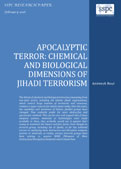Apocalyptic Terror: Chemical and Biological Dimensions of Jihadi Terrorism

The threat of chemical and biological terrorism emanating from non-state actors, including the Islamic Jihadi organisations, which control large swathes of territories and resources, remains a major concern for nation-states today. Over the years, the capability and intentions of Islamic jihadist groups have changed. They evidently prefer for more destructive and spectacular methods. This can be very well argued that if these weapons systems, materials or technologies were made available to them, they probably would use it against their enemy to maximize the impact and fear factor. Even though no terrorist group, including the Al Qaeda, so far has achieved success in employing these destructive and disruptive weapons systems or materials, in reality, various terrorist groups have been seeking to acquire WMD (Weapons of Mass Destruction/Disruption) materials and its know-how.
Much of the literature focused on these speculations and debates during the last decade have shed enough light on the unlikelihood or impossibility of chem- bioterrorism inflicted by Islam-centric Jihadist groups. The argument against the possibilities of such terrorism mostly centered on the premise that technological challenges would be a hindrance for Jihadist groups to weaponize the chem/biomaterials (or pathogens) and deliver them to cause a catastrophic event. This is also somewhat substantiated by the lack of real terrorist events involving chemical or biological weapon materials. Besides events like 2001 Anthrax scare and the 1995 Japanese Subway attacks by Aum Shinrikyo cult, so far chemical or biological weapons have not played a major role in jihadi operations.
However, many Islamic ideologues and jihadists have accepted the use of biological and chemical weapons as a legitimate act of war for mass killings of non-believers. In 2003, Saudi cleric Nasir bin Hamd al-Fahd brought out a treatise on the legal status of using weapons for mass killings, especially against non-believers. Anti-west Islamic clerics like Kuwaiti Professor Abdullah Nafisi reignited the debate on the possibility of chem-bio terrorism events by non-state actors or Islamic Jihadists thereby forcing the naysayers to rethink their conclusions regarding the WMD terrorism event.
There are also newer evidences that suggest that groups like Al Qaeda and its most violent offshoot, the Islamic State (formerly ISIS), are more than capable of using chemical and biological weapon materials targeting civilian population or military. Their intentions to use these types of weapons have been made clear through available jihadi literature. The religious extremists, whether in Pakistan or in Syria, want to take over the State and its military arsenals, industries and infrastructures. Such a mindset amongst the extremists has increased the spectre of chem/bioterrorism scenarios in multitude in recent years.
Moreover, the looming threat is no more based on fear or imagination. The changing jihadi strategy on weapons of war, credible evidence of their focus to seize or acquire WMDs and their willingness to use these weapons to inflict mass fatality or injury make this issue urgent for policy discourse.
This paper was originally published in Namrata Goswamy (ed), INDIA’S APPROACH TO ASIA Strategy, Geopolitics and Responsibility, IDSA/Pentagon Press, 2016.